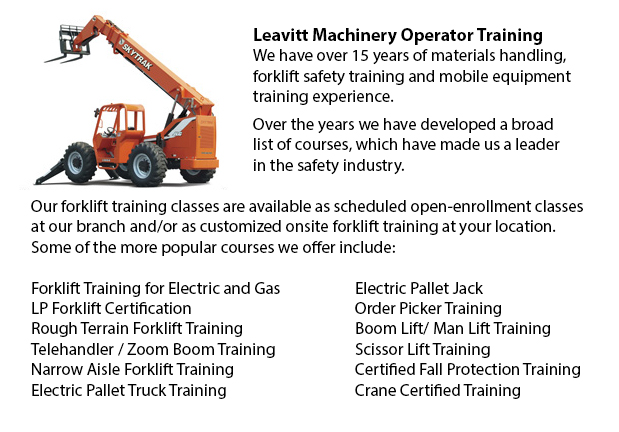
Guelph Telehandler License - A telescopic handler or telehandler is a machine that is frequently utilized in agricultural and industrial applications. It has a similar look to a forklift and even works in a similar manner, though, the telehandler is more of a crane than a lift truck. It has a telescopic boom which could lengthen upward and forwards from the vehicle. The boom has the capability to fit one of several attachments including muck grab, pallet forks, a bucket or a lift table.
The most common telehandler attachments are pallet forks. The telehandler is used in order to transport items in places where the loads cannot be transported by a typical lift truck. Telehandlers are particularly helpful for placing loads on rooftops for instance, or for removing palletized cargo from with a trailer. Many of the tasks which a telehandler could accomplish will otherwise require a crane and this piece of equipment can be costly, not practical and not always time efficient.
As the boom raises or extends while bearing a load, it also acts as a lever. Even with the counterweights in the rear, this causes the equipment to become increasingly unstable; hence, the advantage of the telehandler is actually its greatest limitation. As the working radius increases, the lifting capacity decreases. The working radius is defined as the distance between the front of the wheels and the center of the load.
Like for example, a telehandler with a 5000 lb capability with the boom retracted can safely lift as little as 400 lb when it is fully extended at a low boom angle. The equivalent machine that has a 5000 lb lift capacity and the boom retracted could support up to 10,000 lb with the boom raised to 70 degrees. The operator has a load chart to help determine whether a particular lifting task could be completed in a safe and efficient manner. This chart takes into consideration the weight, height and the boom angle.
Various telehandlers come outfitted with a computer that utilizes sensors in order to monitor the motor vehicle. These sensors will alert the operator and some are capable of cutting off further control input if the limits of the vehicle are exceeded. Some telehandler kinds are also outfitted with front outriggers which are called mobile cranes. These really extend the lifting capability of the apparatus while it is stationary.
-
Guelph Warehouse Forklift Training Classes
Guelph Warehouse Forklift Training Classes - Warehouse training classes exist for the reason of raising awareness regarding common warehouse hazards. Students learn the important safety procedures that are necessary to warehouse safety. An emphasis i... More -
Guelph Forklift Operator Certification
Guelph Forklift Operator Certification - Certification for forklifts are needed to guarantee the safe use of forklifts for those employers in construction, industrial and warehouse settings. The training has to involve a method of education plus some... More -
Guelph Crane Training School
Guelph Crane Training School - The crane training school offers industry-relevant programs. Courses provide trainees with learning results that match current industry demands. Our small class sizes combine hands-on experience and theory. Our qualifie... More -
Guelph Heavy Equipment Training Programs
Guelph Heavy Equipment Training Programs - At whatever given construction site, there are usually various kinds of machines that are ready to be used. These heavy and light equipment need both operators to run them and mechanics to fix them. Apprenti... More -
Guelph Skid Steer Ticket
Guelph Skid Steer Ticket - On a skid-steer loader, the lift arms are at the side of the driver together with pivot points at the back of the driver's shoulders. This makes them different compared to a traditional front loader. Because of the operator... More -
Guelph Zoom Boom Ticket
Guelph Zoom Boom Ticket - Zoom Boom Training focuses on correctly training prospective operators on variable reach forklifts. The training goals include gaining the understanding of the equipments physics and to define the tasks of the operator. This... More -
Guelph Heavy Equipment Training
Guelph Heavy Equipment Training - Commonly, the different types of heavy equipment training are divided into 2 categories of machinery: those that have rubber tires and tracked vehicles. Tracked vehicles consist of items like for instance bulldozers,... More -
Guelph Aerial Lift Safety Training
Guelph Aerial Lift Safety Training - Each year, there are roughly 26 construction deaths due to the use of aerial lifts. Nearly all of the craftsmen killed are laborers, electrical workers, carpenters, painters or ironworkers. Nearly all deaths are c... More

Forklift Certification Guelph
TOLL FREE: 1-888-254-6157
Guelph, Ontario
forkliftcertificationguelph.com
Email Us
About Us


